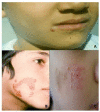A comprehensive review of cutaneous leishmaniasis in kerman province, southeastern iran-narrative review article
- PMID: 25905072
- PMCID: PMC4402407
A comprehensive review of cutaneous leishmaniasis in kerman province, southeastern iran-narrative review article
Abstract
Background: Cutaneous leishmaniasis (CL) remains a serious public health concern in Kerman Province, eastern Iran. This study was aimed to conduct a comprehensive review and highlights various aspects of CL in the province of Kerman.
Methods: This article mainly focuses on the studies published in the past 26 years on CL in the province. Current data for the present status were obtained through the provincial health system.
Results: Bam was the most infected district (63.6%), followed by Kerman (24.7%) and other districts to a less extent. Leishmania tropica is the major causative agent (95.5%) of CL in Kerman province, however, L. major accounts for 4.5% of the total cases. Bam, Kerman and southern districts of Kerman province were purely anthroponotic CL (ACL), while Rafsanjan, Baft, and Sirjan showed both ACL and zoonotic CL (ZCL). In contrast, Orzoieh district was merely endemic to ZCL type. Phlebotomus sergenti was the main vector in ACL foci while Ph. papatasi was the major vector in the ZCL district of Orzoieh. Localized CL was the most prevalent form (80%) of the disease, while leishmaniasis recidivans was the most uncommon clinical manifestation (18.7%).
Conclusion: Due to recent rises in CL disease both in regard of increases in incidence rate and expansion of the disease to new foci, and presence of various risk factors in the province, control measures and health strategies should have high priorities to help treat the existing cases and prevent the expansion of the disease to new areas.
Keywords: Cutaneous leishmaniasis; Iran; Leishmania major; Leishmania tropica.
Figures

References
-
- Ashford RW. ( 2000). The leishmaniasis as emerging and reemerging zoonoses. Int J Parasit, 30: 1269– 1281. - PubMed
-
- 3-Daszak P, Cunningham AA, Hyatt AD. ( 2001). Anthropogenic environmental change and the emergence of infectious diseases in wildlife. Acta Tropica, 78: 103– 116. - PubMed
-
- Desjeux P. ( 2001). The increase in risk factors for the leishmaniasis worldwide. Trans Roy Soc Trop Med Hyg, 95: 239– 243. - PubMed
-
- Jeddi F, Piarroux R, Mary C. ( 2011). Antimony resistance in Leishmania, focusing on experimental research. Journal of Tropical Medicine. http://dx.doi.org/10.1155/2011/695382. - DOI - PMC - PubMed
Publication types
LinkOut - more resources
Full Text Sources
Miscellaneous
